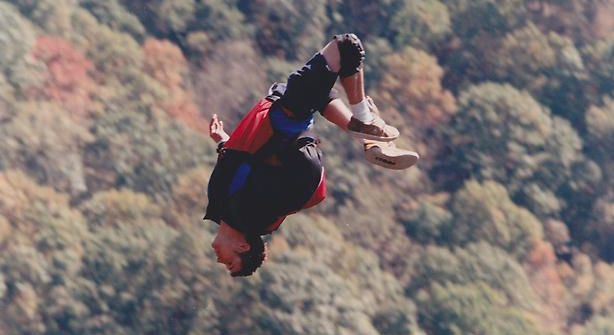Training for a Gainer
by Johnny Utah

|
Practice at a pool. Launching from a solid base is more realistic for most exit points. If you have access to a solid diving platform, then that is ideal. If you do not have one available then you can practice standing exits from a springboard and running exits from the edge of the pool (if the water level is somewhat lower than the edge of the pool). If you don't have access to a pool that will work, then you may know of a swimming hole or a boat dock that will suffice. While practicing at the pool, focus on looking at a point that is behind you before you start the rotation. On a BASE jump this point would possibly be the exit point...makes for a sweet visual. The danger you are training to avoid is either under rotating or over rotating. Why? Because deploying in an unstable body position can result in several problems, such as bridle entanglement, pilot chute-in-tow, off heading openings, and line twist. Here is the HOT TIP. Once you have rotated to a head down body position, you can safely deploy. Any momentum will continue to rotate your body towards a belly to earth position as your parachute is extracted from the container. If you were to wait until you were flat belly to earth to deploy, you have a high chance of over rotating as your parachute comes out. So, while practicing at the pool, try to learn how to enter the water headfirst and vertical. Hitting the water is the ending point of your practice jump at the pool...like wise, this head down body position is the first moment of your rotation when it is safe to deploy. This does not mean it is the ideal time to deploy. What I like to do is deploy once my body has passed through that vertical plain and I am approaching about a 45-degree angle; so I am not flat belly to earth yet. You will have to figure out that perfect timing for yourself. But the window for a safe deployment is between the vertical head down body position and flat belly to earth. Having said that, I would like to stress 3 old sayings my first Jump Master told me back in Cedar Valley, Utah, 1984:
Here is an all time classic I picked up along the way:
My point is this. Your jump priorities (from exit until freefall ends) are: In other words, if you do not have enough altitude to get stable, then you must deploy unstable (as bad as that sucks, we usually get away with it...sometimes we dont). This leads to my next suggestion. Do not attempt your first gainer at the Perrine Bridge. Although it is not a low jump, it is not a high jump either. The best place to try your first gainer is at Bridge Day or a similar object. Something you wont hit if you should have on off heading or line twist, and something high enough that you gain enough airspeed to right yourself before deploying.
Here are three more safety tips:
|